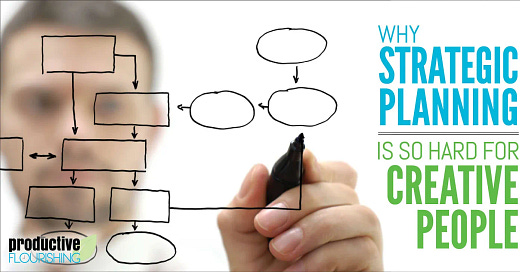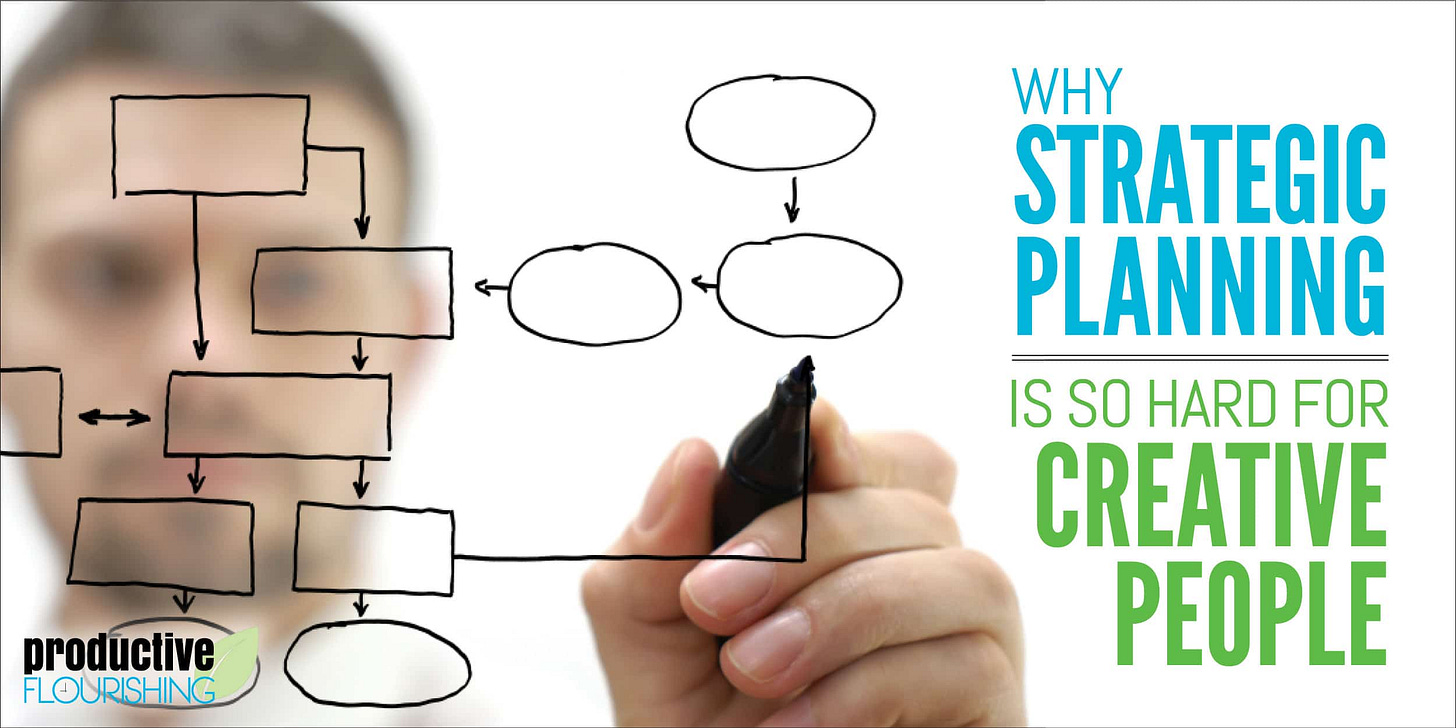Why Strategic Planning Is So Hard for Creative People
It's often emotionally easier in the short term to leave options open than to make a hard strategic choice about what you won't or can't do.
"The essence of strategy is that you must set limits on what you're trying to accomplish." –Michael Porter
Big-picture planning, aka strategic planning, can be really hard work, and not for the reasons you might expect. It's easy to think that the hard part of the planning is the conceptual part. When you do strategic planning right, though, you see that it's actually not conceptually hard — it's not rocket science.
No, what makes strategic planning hard for creative people is that, when you do it right, it comes with some sadness, frustration, and regret. Given the real constraints of time, energy, and attention, some projects will lose out when they're in a project cagematch, but we're often not ready to accept that we can't do them. I was thinking about this recently in considering my strategic projects for next year.
Last week, I officially came out of my unofficial leave of absence in my doctoral program. I plan on finishing that up next year. (Update: a car accident ended up rewriting my plans and, by the time I had recovered, new priorities emerged, notably a book deal for Start Finishing.)
That's one Big Project down. I get no more than 2 more, and that project favors or disfavors other Big Projects. (Big Projects = objectives or initiatives for our planners, in case you use those to help with your planning.)
For instance, it wouldn't make sense for me to choose goals that require a lot of travel to accomplish. The disruption of travel prevents me from doing a lot of other things. As much as I wish I were a digital nomad who could do deep work while traveling, the reality is that I work best when I’m rooted for a while.
A contender for 2014 is Start Finishing (my book on finishing the stuff that matters). Finishing a dissertation and a book simultaneously may be is definitely out of my reach, though. Odds are, neither will get done, and that’s unacceptable. Been there, done that. My closet is full of T-shirts from that theme park. (And as of September 2019, I’m excited to share that my book is now available!)
Therein is that sadness and frustration. Both projects are meaningful to me. The level of short-term impact may be dramatically different. I could write a book that many thousands will read versus a book (dissertation) that all of 8 people might read, and 5 of them have to because they're on my committee. The long-term impact of finishing my doctorate (for me, if nothing else) may be greater.
I see that I can't do both and I have to choose one over the other. That choice comes with some grief, frustration, and futile negotiation. It's easier to not make a choice about it.
2024 Update: Books keep winning and, at this point, I’ve intentionally decided to leave my dissertation and doctorate unfinished. In an unexpected turn of events, professors and instructors are teaching content from my books in college classes. Funny how that works out.
Don't Just Put It on the List
You might be thinking, "You could always put it on your list. So what if you don't get it done?" That sounds good, in theory. In practice, it's the seed for a story that doesn’t bode well for me.
Creative work has this simultaneously exciting and annoying fact about it: it's never really done. Yet one of the precepts that my research, observation, and work in the trenches have yielded is that we are most satisfied when we're making progress on the work that matters to us. We need not to finish, but to see progress.
And this is precisely what messes us up when it comes to both strategic planning and being successful in Project World. We might get emotional satisfaction from making progress on things, but our holistic success depends on our actually finishing things.
As I work with clients on strategic planning, I know we're not done until we've worked through some sadness and frustration. If we haven't let something go that matters to them, we're not being realistic yet. Yes, I know that realistic is a term that creatives, entrepreneurs, and leaders wish would go away or consider to be scarcity thinking; it's also true that a bit of our path depends on being functionally delusional.
But one of the best disciplines to cultivate is focusing on the fewer things that really matter and truly getting behind them. Remember: "Not Now" doesn't mean "No".
It's not that I enjoy this phase of the planning process with clients. It's that I've learned that if we don't do the planning together, it might not get done until it's too late. The project cascade will already be in effect and we'll be reacting to meet or adjust commitments and expectations at the cost of actually meeting them.
So, as I work through my own strategic planning, I know that I'm making progress if I'm sad and frustrated. That's not a sign that something's wrong with the process or me, but rather a sign that to be human means to be bounded by space and time. And those few things that get chosen better damn well be worth it. Everything we do comes at the cost of something else we could've done.
It Might Not Work – and That's Okay
By the way, the "this better be worth it" or "this must work" sentiments also set up a lot of head trash, too. How many times have you regretted choosing one path over the other, only to have that regret paralyze you when it's time to make another choice? (I call this thrashing in Start Finishing.)
Better to approach it from a "This Might Not Work" mentality, as Steven Pressfield explains one of Seth Godin's hallmarks. Sure, what you're planning to do might not work, AND it's worth going after. Besides, success often comes when you're not looking for it, anyway.
What we often fail to consider, though, is that "This Might Not Work" is also true of whatever else we might or might not have put on the list.
We instead assume that what wasn't chosen would've been successful. I'm not sure why we do this, but I suspect it's because we don't want to go through the heartache of both starting over AND potentially seeing that we chose wrong again. That, and most of us have learned to be overly critical of ourselves, to the near-exclusion of practicing self-compassion.
I wish I could make the emotional part of strategic planning less of a challenge than it is. I hope that by being aware of it, though, you're able to work through it better. Because, trust me, if you're not working through it, you're not planning to do your best work - you're only hoping to do it.
When we think about thriving, we tend to think big picture, but the reality is that it’s the accumulation of purposeful and productive days that lead to our thriving. We become by doing, and the days are where the doing happens.
Which is exactly why you need a project roadmap, a specific kind of project plan that chunks, links, and sequences the project over time. Henry Ford said, “Nothing is particularly hard if you divide it into small jobs.”
The road map helps us convert the vertical list of to-dos into a horizontal, time-based plan — a daily list of to-dos that align with our big-picture goals. And we thrive when we do our best work. This intentional roadmap provides the momentum we need to get from idea to done. And when we thrive, there’s no room for negative emotion or regret.
If your big-picture planning isn't making you emotional, you're not done planning yet.
On the other side of that emotional work, though, is the awesome feeling of learning just how amazing you can be and seeing your best work being received by the world. You can't be everything to everybody all at once, but you can do epic shit the same way anybody does: choose what matters, actually commit to it, and really show up.
Get to it.





